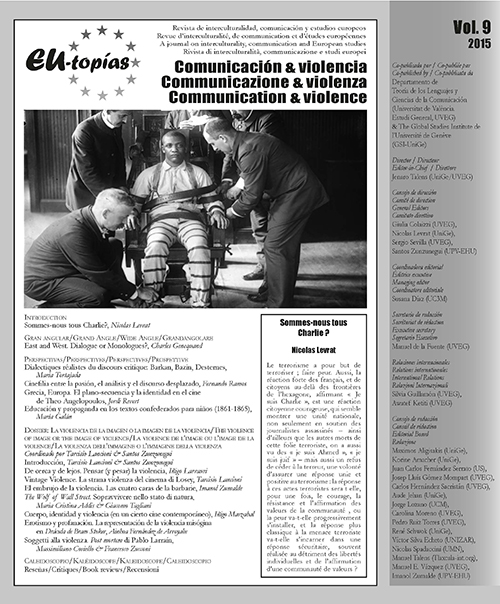Vintage Violence. La strana violenza del cinema di Losey
DOI:
https://doi.org/10.7203/eutopias.0.18750Keywords:
Violence, Semiotics, Enunciational theory, Figural Device, Gilles Deleuze, Louis Marin, Joseph Losey Abstract
Abstract
Texts about violence tend to take this concept for granted. This article tries to sketch a semiotic definition through a brief re-reading of some classics and of some vocabulary entries, to suggest a characterisation of violence as a semiotic device: an articulation of two different figures of aggression («laceration»/«constraint») against a conventional threshold. This hypothesis is developed in the analysis of Joseph Losey’s films, where violence appears in many forms, but never becomes (with rare exceptions) totally explicit or spectacular. The article reconsiders the analysis by Gilles Deleuze in his L’Image-Mouvement, where Losey’s violence is essentially related to the actor’s body and its power to vibrate under the influence of original «drives». But in Losey’s cinema there are also others expressions of violence, that the article tries to understand following the suggested device. It finally focuses on The Lawless, considered here as a reflection on the dynamics of violence building, through a complex play between the film’s diegetic development and the strategies to involve the viewer.
 Downloads
Downloads
 References
References
Balibar, Étienne (2005), «Violenza: idealità e crudeltà», Françoise Héritier, De la violence : Tome 1, Paris: Odile Jacob [tr. it. Sulla violenza, Roma: Meltemi 2005].
Calabrese, Omar (2006), Come si legge un’opera d’arte, Milano: Mondadori Università.
Ciment, Michel (1979), Le livre de Losey, Paris: Stock [tr. it. Il libro di Losey: un dialogo autobiografico. Roma: Bulzoni, 1983].
Daney, Serge (1984), «Losey. Cinq paradoxes», Libération, 24 giugno.
Del Marco, Vincenza & Pezzini, Isabella (ed.) (2012), Passioni Collettive. Cultura, politica e società, Roma: Nuo- va Cultura.
Deleuze, Gilles (1983), Cinéma 1. L’image-mouvement, Paris: Minuit [tr. it. Cinema 1. L’immagine-movimento, Milano: Ubulibri, 1984].
Fabbri, Paolo & Sbisa’, Marina (1985), «Appunti per una semiotica delle passioni», aut-aut, 208 [Ora in faBBri, Paolo & marrone, Gianfranco (2001), Semiotica in nuce. Vol. II. Teoria del discorso, Roma: Meltemi, 2001].
Greimas, Algirdas J. & Courtés, Joseph (1979), Sémiotique. Dictionnaire raisonnée de la théorie du langage, Paris: Hachette [tr. it.Semiotica. Dizionario ragionato della teoria del linguaggio, Milano: Bruno Mondadori, 2007, nuova ed. curata da Paolo Fabbri].
Greimas, Algirdas J. & Fontanille, Jacques (1991), Sémiotique des passions. Des états de choses aux états d’ âme, Paris: Seuil [tr. it. Semiotica delle passioni. Dagli stati di cose agli stati d’animo, Milano: Bompiani, 1996].
Héritier, Françoise (2005), «Riflessioni per nutrire la riflessione», De la violence: Tome 1, Paris: Odile Jacob [tr. it. Sulla violenza, Roma: Meltemi 2005].
Lancioni, Tarcisio (2009), Immagini narrate. Semiotica figurativa e testo letterario, Milano: Mondadori Università.
— (2012), «The Lawless. Passioni e azione collettiva», Vincenza del Marco & Isabella Pezzini (ed.) (2012), Passioni Collettive. Cultura, politica e società, Roma: Edizioni Nuova Cultura, pp. 128-153.
Landowski, Eric (2005), Les interactions risquées, Limoges: Pulim.
Lotman, Jurij (1973), Semiotika kino i problemi kinoestetiki,
Tallin: Eesti Raamat [tr. it. Semiotica del cinema, Edizioni del Prisma: Catania, 1994].
Manchia, Valentina (ed.) (2014), «Immagini che fanno segno. Modi e pratiche di rappresentazione diagram- matica nelle informational images», Carte Semiotiche. Annali 2, Firenze-Lucca: La Casa Usher.
Marin, Louis (1981), Le portrait du roi, Paris: Minuit.
— (1993), Des pouvoirs de l’image, Gloses, Paris: Seuil.
— (2005), Politiques de la représentation, Paris: Kimé. marrone, Gianfranco (2005), La cura Ludovico. Sofferenze e beatitudini di un corpo sociale, Torino: Einaudi.
Downloads
Published
How to Cite
-
Abstract210
-
PDF 57
Issue
Section
License
![]()
The authors conserve the copyright. All content published in EU-topías. Journal of interculturality, Communication, and European Studies are subject to the license Creative Commons Attribution-NonCommercial-ShareAlike 4.0 license. The full text of the license can be found at <http://creativecommons.org/licenses/by-nc-sa/4.0>
They may be copied, used, disseminated, transmitted and publicly displayed, provided that:
- The authorship and original source of the publication is cited (journal, publisher and URL of the work).
- They are not used for commercial purposes.
- The existence and specifications of this license of use are mentioned.
It is the responsibility of the authors to obtain the necessary permissions for images that are subject to copyright.



